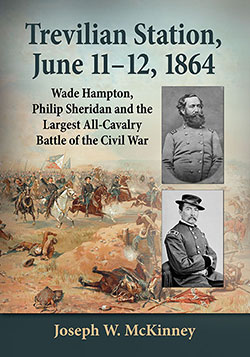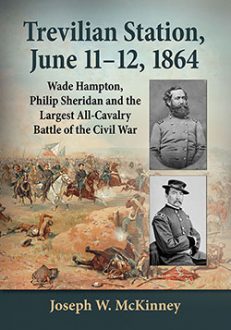Trevilian Station, June 11–12, 1864
Wade Hampton, Philip Sheridan and the Largest All-Cavalry Battle of the Civil War
$39.95
In stock
About the Book
In June 1864, General Ulysses Grant ordered his cavalry commander, Philip Sheridan, to conduct a raid to destroy the Virginia Central Railroad between Charlottesville and Richmond. Sheridan fell short of his objective when he was defeated by General Wade Hampton’s cavalry in a two-day battle at Trevilian Station.
The first day’s fighting saw dismounted Yankees and Rebels engaged at close range in dense forest. By day’s end, Hampton had withdrawn to the west. Advancing the next morning, Sheridan found Hampton dug in behind hastily built fortifications and launched seven dismounted assaults, each repulsed with heavy casualties. As darkness fell, the Confederates counterattacked, driving the Union forces from the field.
Sheridan began his withdrawal that night, an ordeal for his men, the Union wounded and Confederate prisoners brought off the field and the hundreds of starved and exhausted horses that marked his retreat, killed to prevent their falling into Confederate hands.
About the Author(s)
Bibliographic Details
Joseph W. McKinney
Format: softcover (7 x 10)
Pages: 360
Bibliographic Info: 92 photos & illustrations, appendices, notes, bibliography, index
Copyright Date: 2016
pISBN: 978-0-7864-9903-8
eISBN: 978-1-4766-2320-7
Imprint: McFarland
Table of Contents
Table of Contents
Preface 1
Introduction 3
1. “I had rather die than be whipped”: The Battle at Yellow Tavern and the Death of J.E.B. Stuart 7
2. “Proper commanders. Where can they be obtained?”: Lee Defers Selecting a Cavalry Commander 18
3. “Strike fast and strong”: Evolution of the Cavalry Corps, Army of Northern Virginia 26
4. “When am I to get another horse?”: Confederate Cavalry Regiments—New Commanders, Old Problems 32
5. The “New Issue”: Reinforcements for Lee’s Cavalry 41
6. “The Very Man I want”: Philip Sheridan and His Senior Commanders 63
7. Veteran Volunteers: Manning, Mounting, and Arming Union Cavalry 79
8. “I will not fight under the orders of a Dutchman”: Changes in Composition of the Union Cavalry Corps 94
9. “Break up the railroad”: Grant’s Concept for a Cavalry Raid 104
10. “Thumping along”: The March to Louisa County 115
11. “An exceedingly messed up affair”: The Battle Opens on the Fredericksburg Road 122
12. “Where is the 9th N.Y.?”: Union Momentum Builds on the Fredericksburg Road 134
13. “Pardonable zeal”: Colonel Alger’s Charge to Trevilian Station 139
14. “Where the hell is the rear?”: Custer’s First Last Stand 146
15. “Roll them up like a ribbon”: Sheridan Prevails at Trevilian Station 159
16. “Too horrible to dwell upon”: The Night of an Unfinished Battle 169
17. “A theatre of bloodshed”: The Battle Continues on June 12 175
18. “Damn, damn, all the time”: The Union Withdrawal 188
19. “The most disorderly retreat I have seen”: Union Defeat at Samaria Church 200
20. “I regret my inability”: Assessing the Outcome of the Trevilian’s Battle and Raid 212
21. Old Soldiers Fade Away: Lives After the Battle 223
Appendix A. Order of Battle and Casualties 259
Appendix B. West Pointers at Trevilian Station 267
Appendix C. Custer’s Captured Wagons 271
Appendix D. Edward L. Wells and the Hampton vs. Fitz Lee Controversy 275
Chapter Notes 283
Bibliography 327
Index 339
Book Reviews & Awards
“an exceptionally well documented and an impressively detailed, comprehensive, and informative account…extraordinary and highly recommended…outstanding scholarship…extraordinary….recommended”—Midwest Book Review; “an interesting, well written book…highly recommended”—Civil War News; “highly detailed account…well written, and a lively read”—StrategyPage.





